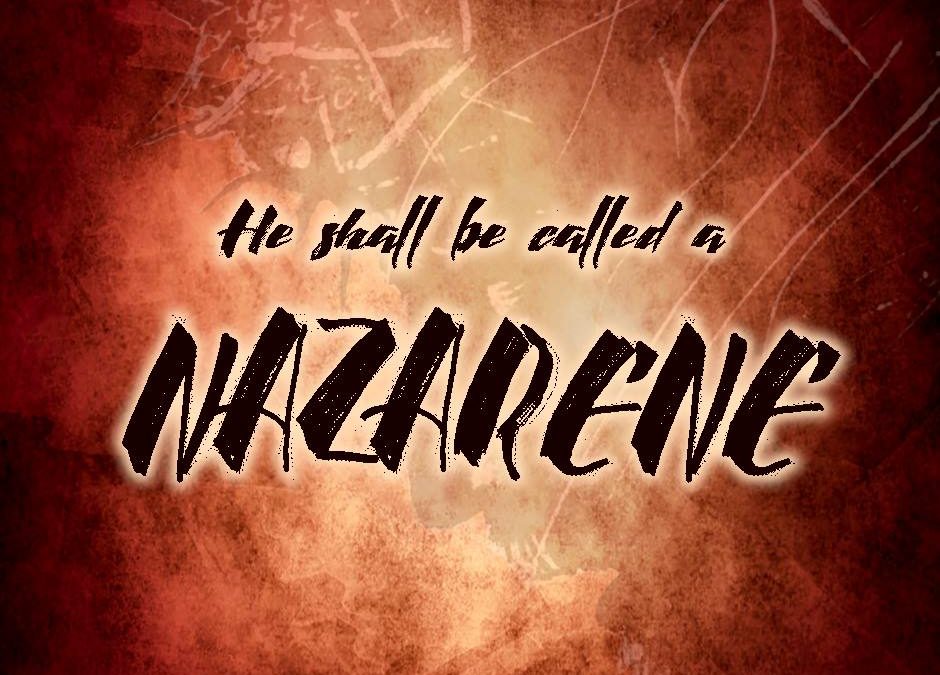Matthew 2:23 He will be called a Nazarene – The prophets never said this!

5.3. Matthew 2:23 says that when Jesus moved to the town of Nazareth, this “fulfilled what was said through the prophets: ‘He will be called a Nazarene.’ ” There’s only one problem. The prophets never said this! Matthew actually made it up.
If you’ll look closely at the text, you’ll see that Matthew does not use his normal quotation formula for citing verses from the Hebrew Bible. Normally he would say something like, “to fulfill what was spoken through the prophet,” making reference to a specific text in a specific prophetic book.
In 2:23 he says, “so that what had been spoken through the prophets might be fulfilled,” indicating that he is dealing with a theme (or play on words) that occurs in several prophetic books as opposed to only one text in a specific prophetic book. With this in mind, it’s not difficult to see the sections from the Tanakh that Matthew had in mind. As always with Matthew, his insights are deep.
More than any New Testament author, Matthew makes constant reference to the Hebrew Bible when describing the life, death, and resurrection of Yeshua (see also immediately above, 5.2). Every major event that took place in the Messiah’s life took place “to fulfill what was said” through a specific prophet in the Tanakh. God had laid it out in advance! Matthew uses this form of speech frequently (see Matt. 1:22; 2:15; 2:17; 4:14; 8:17; 12:17; 13:35; 21:4; 27:9).
Now, in almost every instance, Matthew makes reference to one particular prophet or prophecy, unless he is referring to several events that took place in the life of Jesus. In that case reference is made to “the Scriptures” (plural) being fulfilled (Matt. 26:54) or it is explained that certain things occurred “that the writings of the prophets [plural] might be fulfilled” (Matt. 26:56; see also Luke 24:44).
Also, every time he makes reference to a specific prophetic utterance, he follows it with the word “saying,” indicating a direct quote from the Tanakh. But in Matthew 2:23, we read that when Jesus and his family settled in Nazareth, “So was fulfilled what was said through the prophets: ‘He will be called a Nazarene.’
”63 (Remember that there were no quotation marks in the original text, and so it is misleading to have them in our English translations, since it gives the impression that there is a direct citation.) From looking at this formula, we can see clearly that Matthew was not looking at one particular prophecy (he refers to “the prophets” and omits the word “saying”). Rather, he had in mind a theme or common thread found in several prophetic books. The question is: What exactly was he thinking of? Which texts and which themes?64
Bearing in mind that Matthew’s use of the Tanakh was the fruit of much careful thought and reflection, and remembering that he shows a clear knowledge of the Hebrew text of Scripture (see above, 5.1; cf. also 5.4), we would do well to look for two things: First, is there a play on words that caught his attention? (As we saw above, 5.1, this was very common in Jewish biblical interpretation.) Second, is there a related Messianic theme? The answer to both questions is yes, and the key again is context. In Matthew 1:23, reference is made to Isaiah 7:14, while in Matthew 4:12–16, reference is made to Isaiah 9:1–2[8:23–9:1].
And these chapters are part of an important Messianic section in Isaiah (chapters 7–11), culminating with the major Messianic prophecy in Isaiah 11 which begins with these words: “A shoot will come up from the stump of Jesse; from his roots a Branch will bear fruit” (Isa. 11:1). And what is the Hebrew word used here for “Branch”? It is netser, a form closely related to the Hebrew word for Nazareth.65
This is important for several reasons: First, it shows us that Matthew had the entire Messianic section of Isaiah 7–11 in view when he quoted prophecies regarding Yeshua’s birth (Isa. 7:14; see vol. 3, 4.3) and early life (Isa. 9:1–2[8:23–9:1] and 11:1). Second, it gives us a clear link to the word Nazareth. Third, it ties in with the well-known concept of the Messiah being called “the Branch” (elsewhere with the Hebrew word tsemach; see Jer. 23:5; 33:15; Zech. 3:8; 6:12; cf. also Isa. 4:2; in Rabbinic literature, as well as in the Dead Sea Scrolls, the Messiah was sometimes referred to as netser, and there is a Talmudic story—speaking disparagingly of Jesus—in which one of his disciples is called netser).66
Fourth, both in the context of Isaiah 11:1 and in the lowly reputation of Nazareth, it ties in with the humble origins of the Messiah (see also Isa. 53:1–3; and cf. vol. 3, 4.11; the lowly reputation of Nazareth is reflected in Nathanael’s words in John 1:46a upon hearing the claim that the Messiah was a man from Nazareth.
As paraphrased in The Message, he exclaimed, “Nazareth? You’ve got to be kidding.”)67 Therefore, rather than being something that Matthew made up—as if he would have fooled his Jewish readers anyway!—this verse reminds us of how insightful Matthew was in opening up the true meaning of the Tanakh.68 And this should come as no surprise to us: He was taught by the Messiah himself! (See Luke 24:44–45.)
Finally, as noted by other scholars, Ezra 9:10–12 provides an interesting parallel to Matthew 2:23, since Ezra, while praying and repenting, says to the Lord:
For we have disregarded the commands you gave through your servants the prophets when you said, “The land you are entering to possess is a land polluted by the corruption of its peoples. By their detestable practices they have filled it with their impurity from one end to the other. Therefore, do not give your daughters in marriage to their sons or take their daughters for your sons. Do not seek a treaty of friendship with them at any time, that you may be strong and eat the good things of the land and leave it to your children as an everlasting inheritance.”
The problem, of course, is that these exact words are not found anywhere in the prophetic books in the Tanakh, yet Ezra claims to be quoting the Lord’s word spoken through the prophets. Was Ezra making this up? Was he intentionally falsifying things so as to delude the people? Or, since he was quoting these words to God in prayer, was he trying to delude the Lord? Putting sarcasm aside, it is clear that he was summarizing and paraphrasing the consistent message of God’s prophets—notice that he refers to “prophets” in the plural just as Matthew did—even though it would appear at first glance that this was a literal quotation (see further Deut. 11:8–9; Isa. 1:19; Ezek. 37:25; and cf. Lev. 18:24–26; Deut. 7:1–6; 2 Kings 17; 23:8–16; Ezek. 5:11).
Of course, someone could argue that Ezra was quoting from some lost prophetic books, but then we could just as well argue that Matthew was doing the same! To do so in either case is completely unnecessary. Ezra was simply restating the consistent message of the prophets in his own words; Matthew was making reference to a common Messianic theme, one which caught his attention through an interesting play on words—a wonderfully perceptive and rich interpretation.69
Putting yourself in Matthew’s shoes—he was an eyewitness of the Messiah’s teaching, miracles, death, resurrection, and ascension—and then looking back at the Hebrew Bible through his eyes, with the understanding that everything that was written in the Tanakh ultimately pointed towards the Messiah, discovering insights such as these must have been a further source of inspiration. God so wonderfully laid out his redemptive plan in advance!
63 For some of the philological issues involved in the Greek term nazōraios, cf. M. O. Wise, “Nazarene,” in Joel B. Green and Scot McKnight, eds., Dictionary of Jesus and the Gospels, 571–74. He understands the term to mean, “the man from Nazareth.”
64 Making no attempt to understand Matthew here, Drazin, Their Hollow Inheritance, 41, lists Matthew 2:23 as proof that the New Testament “resorts to imaginary quotations,” citing also Matthew 27:9–10 (see immediately below, 5.4); John 7:37–38; and James 4:5. For the latter two, see the standard commentaries.
65 Richard Longenecker (in his Biblical Exegesis in the Apostolic Period), among others, raised some philological strictures against this identification, but these have been countered fairly by the Aramaic scholar Michael Wise (in his article “Nazarene,” cited above, n. 63); among Matthew commentaries that address this issue, see especially Davies and Allison.
66 For the Talmudic account, cf. b. Sanh 43a; for netser as a title of the Messiah in ancient Jewish literature, see the references collected in S-B, 1:94; Testament of Judah 24:6; 4QpIsa 3:15–26; cf. further Davies and Allison, Matthew 1–7, 277–78.
67 As noted by George R. Beasley-Murray, John, Word Biblical Commentary (Dallas: Word, 1987), 27, “Nathanael’s expostulation at the idea that the Messiah could come from Nazareth is comprehensible, for Nazareth was utterly insignificant; it has no mention in the OT, the Talmud or Midrash, or in any contemporary pagan writings ([Strack-Billerbeck] cite one reference to Nazareth from a Jewish writer ca. a.d. 800).
The residence of Jesus in Nazareth is akin to his birth in a stable; it is part of the offense of the incarnation. Philip therefore can only reply, ‘Come and see’; the answer to the offense of the incarnation is Jesus himself.”
68 For other possible verses and/or concepts that Matthew may have had in mind, cf. Davies and Allison, Matthew 1–7, 274–81 (their first choice is for the association with nazir, Nazarite, holy person, with special reference to Isa 4:3; they see the netser reference as secondary); Keener, Matthew, 113–15; Nolland, Gospel of Matthew, 128–31.
According to Carson, “Matthew,” EBC, 8:97, “[Matthew] is not saying that a particular OT prophet foretold that the Messiah would live in Nazareth; he is saying that the OT prophets foretold that the Messiah would be despised (cf. Pss 22:6–8, 13; 69:8, 20–21; Isa 11:1; 49:7; 53:2–3, 8; Dan 9:26). The theme is repeatedly picked up by Matthew (e.g., 8:20, 11:16-19, 15:7-8 8:20; 11:16–19; 15:7–8). In other words Matthew gives us the substance of several OT passages, not a direct quotation.…
It is possible that at the same time there is a discreet allusion to the neṣer (‘branch’) of Isaiah 11:1, which received a messianic interpretation in the Targum’s rabbinic literature, and the Dead Sea Scrolls (cf. Gundry, Use of Old Testament, 104); for here too it is affirmed that David’s son would emerge from humble obscurity and low state.
Jesus is King Messiah, Son of God, Son of David; but he was a branch from a royal line hacked down to a stump and reared in surroundings guaranteed to win him scorn. Jesus the Messiah, Matthew is telling us, did not introduce his kingdom with outward show or present himself with the pomp of an earthly monarch. In accord with prophecy he came as the despised Servant of the Lord.”
69 It should be noted that there are plays on words—but stated as if they were linguistically accurate—within the Tanakh itself, such as babel (Babylon) being derived from b-l-l, to confuse (see Gen. 11:9), whereas it is derived from Akkadian bab ilani, gate of the gods.
Brown, M. L. (2007). Answering Jewish objections to Jesus, Volume 4: New Testament objections. (24). Grand Rapids, Mich.; Baker Books.

![The New Testament misquotes and misinterprets the Old Testament. [Answered] 8 The New Testament misquotes and misinterprets the Old Testament. [Answered]](https://difa3iat.com/en/wp-content/uploads/2023/06/OL3Ii-e1687210424729.jpg)
![Born to a virgin? just one of several pagan myths [Answered] 9 Born to a virgin? just one of several pagan myths [Answered]](https://difa3iat.com/en/wp-content/uploads/2023/07/pwKhu-e1688385358129.jpg)
